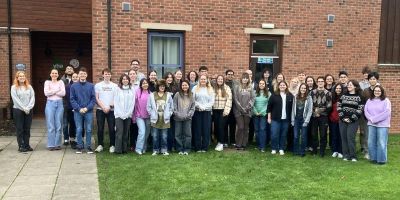Arms race to track the changes in structural biology

Scientists are locked in an arms race to understand the ever-changing structure of proteins, argues a Nobel Prize winning structural biologist.
Dr Richard Henderson - who was at the University of Leeds as part of a scientific conference - says the COVID pandemic has illustrated how quickly proteins can adapt and change, and he said scientists need to keep on top of those changes.
He said: “As you have seen with coronavirus, we get an understanding of the structure of the virus and its proteins but then that structure changes as the virus replicates and mutates.
“Across the natural world, the molecules that make up life are in a state of flux. There is no end to the need to know how the structure of these key biological molecules are altering if we want to develop new medicines and therapies to combat disease in plants and animals.
“We are locked in a scientific arm’s race where we need to keep updating our knowledge about the structure of proteins.”
Seeing inside living cells
Proteins are the building blocks of biology - and the way they interact with other molecules provides the chemical signalling processes necessary for life.
Dr Henderson – a molecular biologist and biophysicist - was jointly awarded the Nobel Prize in 2017 for developing cryo-electron microscopy techniques to determine in high resolution the structure of important biomolecules.
He was at Leeds to deliver the keynote speech at the Astbury Conversation, a meeting of scientists involved in research in structural molecular biology - and named after William Astbury who was appointed Professor of Biomolecular Structure at Leeds in 1945.
The University is also home to the Astbury Centre for Structural Molecular Biology, which brings physicists, chemists and biologists together to understand the workings of living cells.
Professor Astbury was a biophysicist who used some of the analytical methods in physics to investigate and visualise the structure of biological materials. He took some of the first X-ray diffraction images of DNA in 1938 – and is regarded as one of the founding fathers of structural biology. Leeds has a long tradition of developing new techniques for investigating the structure of biological molecules which continues today.
Leeds – powerhouse in structural biology
Professor Simone Buitendijk, Vice-Chancellor of the University of Leeds, said: “It is a great honour to have had Richard taking part in the Astbury Conservation. The work that is happening in structural biology is central to answering some of the toughest questions in biology, including ways that we can better treat or control cancer and other life-limiting diseases.
“The rich contribution that Leeds has made to the field of molecular biology will undoubtedly be continued by the researchers currently developing new ways to see inside cells.”
In 1915, Sir William Henry Bragg, who was Cavendish Professor of Physics at Leeds, was jointly awarded the Nobel Prize with his son Lawrence for their research that led to the creation of a new field of science called X-ray crystallography.
That technique has been used in many subsequent scientific advances and lay the foundation for the research which secured the Nobel Prize for Dr Henderson and his collaborators, which in turn has transformed science.
Dr Henderson said: “Because of Bragg and Astbury and other key scientists in the development of structural biology, not only in the UK but around the world, there are research powerhouses in this field of science – and Leeds is one of them.”
He works at the Medical Research Council Laboratory of Molecular Biology at Cambridge and was formerly its director.
At the end of the Astbury Conversation – which was rescheduled from 2020 because of the COVID pandemic – Professor Buitendijk presented Dr Henderson with a specially created tapestry inspired by his work in structural biology. The tapestry was stitched by Tamsin Lines, a student in the School of Design at the University of Leeds.
Further information
For more details, please contact David Lewis the press office at the University of Leeds via d.lewis@leeds.ac.uk
The image shows left to right: Professor Neil Ranson, Professor Simone Buitendijk and Dr Richard Henderson. Picture credit: Stephen Muench.




